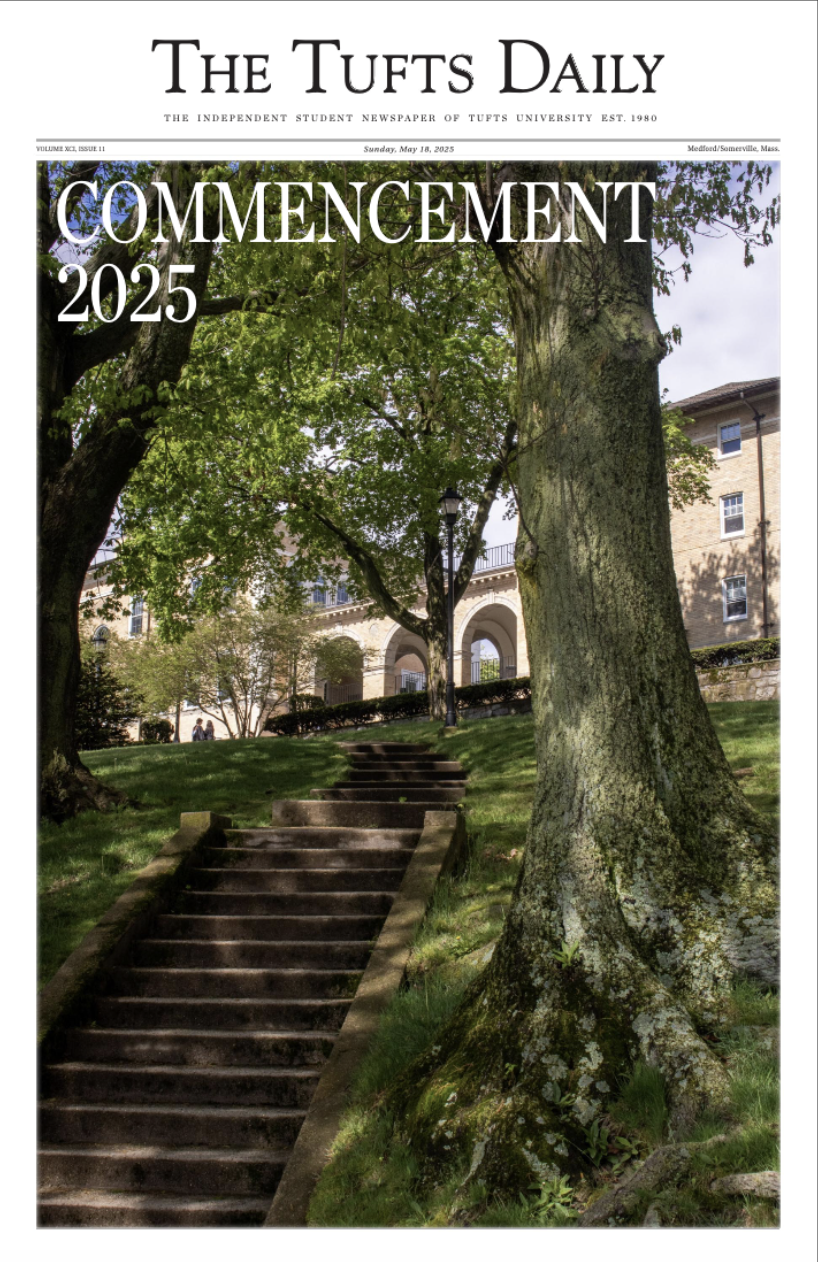Take a walk around the Tufts campus and you’re bound to find at least one newspaper, magazine or journal lying around. Maybe it’s the satirical Zamboni scattered in your dorm’s common room. Perhaps it’s a new edition of the Tufts Observer magazine on the newsstands in the Mayer Campus Center. Or, of course, it could be a Tufts Daily paper left on a table in Tisch Library.
There are over 15 student-produced publications on Tufts campus that vary from well-known academic journals, like the international relations magazine and journal produced by Hemispheres, to creative writing and art, such as the magazines made by Future Histories. Additionally, there are publications outside the confines of humanities with think-tanks like The Lantern, combining art, science and technology using creative layouts in its annual STEM-centered magazine.
Each publication at Tufts amplifies different student voices and ideas about a myriad of issues. These publications have created a community among themselves, serving as each others’ creative inspiration and collaborators. Together, they serve as an outlet for student opinions and art which leave impactful commentary for the Tufts community and beyond.
Hemispheres
Some on-campus publications like the Tufts Historical Review or the Tufts Undergraduate Law Review are purely academic. Hemispheres falls under this category and has created an academic journal since 1976, making it one of the oldest undergraduate international relations journals in the country. The Hemispheres journal goes beyond Tufts as it’s circulated amongst those in the academic community.
“The journal used to go to … the Library of Congress,” Sam Sullivan, a senior and Hemispheres co-editor-in-chief, said. “We used to distribute it to university libraries. … We’re going to try to see if we can start that back up again, but it is pretty well known for being one of the first of its kind.”
The journal includes four to five articles, which are full-length research papers selected by Hemispheres staff from over 30 submissions that are solicited from undergraduate students all around the world. It also includes two to three interviews with ambassadors, professors and other notable people which are conducted by Hemispheres staff. The journal has some additional editorials which are critical academic pieces by its staff writers.
In the fall of 2023, Hemispheres expanded and published its first magazine. The journal and magazine share the same theme; however, the magazine is less formal than the journal and allows every member of Hemispheres to write an essay about an issue that matters to them with the help of peer editing groups.
“The idea was this is supposed to be accessible to the everyday audience. We want it to be as accessible to the [computer science] and [biology] majors as it is to IR majors,” Sullivan said.
While not every student may pick up the full academic journal, Hemispheres hopes that the introduction of the magazine to its repertoire will help inform the student body about what international relations majors are thinking about global issues at this moment.
The magazine also allows Tufts students in Hemispheres to gain experience in academic writing and share their knowledge in a way they weren’t able to in the journal. Both editors-in-chief raved about how many unique things they learned from other club members, from Gen Z’s impact in Kenya to the Bougainville Island’s independence referendum.
“The target audience is the Tufts community because [it’s] about Tufts and our club coming together to express our own opinions,” Ishika Gupta, a senior and the other Hemispheres co-editor-in-chief, said.
Hemispheres’ latest magazine issue “Trading Places” covered themes about changing structures of power in connection to 2024 being the biggest election year to date with half the world’s population having the opportunity to vote. The magazine was released on Tuesday, culminating in around 60 pages of student-written op-ed pieces. Hemispheres provides a space for students to share their ideas in an environment that isn’t a graded classroom.
“[I’ve enjoyed] finding this community of people that really cares about informed discourse on these international issues and being critical about what we are studying at Tufts,” Sullivan said. “People come to seek out a place where they can publish their ideas.”
The magazine gave Hemispheres a new opportunity to focus on a creative layout that would be more appealing to the general Tufts reader. Hemispheres leaned on the community of Tufts publications when taking the steps toward creating a magazine.
“[We have been] drawing inspiration from other on-campus publications, like the Observer and Future Histories,” Sullivan said. “They have a lot of visually appealing, engaging stuff and we wanted that.”
Future Histories
Future Histories, an art and literary magazine, was founded in 2018 by students who found a lack of a general literary magazine at Tufts. While the Observer does creative writing, they have resident writers, a different production system and a different style to that of Future Histories.
“Future Histories was founded with the mission to uplift marginalized voices,” Newt Gordon-Rein, a senior and chair of Future Histories, said.
Although the voices Future Histories shares are more creative than those in the academic Hemispheres publications, both clubs aim to be critical of what they are being taught at Tufts and focus on purely the students’ thoughts, interests and ideas.
“There’s a line somewhere in our constitution about avoiding the evils of the Western literary canon. … There’s just so many ingrained biases, and we’re at an institution that has to respect the great works, but it’s important to keep in mind that there were other great works that didn’t see the light of day because of who wrote them,” Gordon-Rein said. “We’re just doing our little part to try to contribute to a more diverse canon in the future.”
Future Histories has two submission deadlines and reviews content anonymously every week. They also work closely with authors and artists through an editing process that is purely suggestive.
Gordon-Rein’s favorite part of the process is pairing the artwork with the written pieces to “find [the] serendipitous connections between the writing and the art.”
The Lantern
The Lantern is unique in that while it is academic and STEM-oriented, it chooses to explore STEM-related issues through a very creative and artistic magazine format. Despite their different purposes and themes, Future Histories and The Lantern have similar layouts. Maddie Cortesi, a senior who is co-president and head of design for The Lantern, mentioned Future Histories as one of the main inspirations for The Lantern’s magazine layout and general processes.
“The most recent [magazine] last year took a way more diverse format. … We had short stories that were fiction, we had documentary reviews, we had some visual analysis of different art pieces and some academic works as well,” Cortesi said.
Last year, The Lantern included art and more unique formatting, while still containing academic articles.
“Why should a journal have to be boring?” Cortesi said.
The Lantern is primarily a think tank where students share ideas relating to the science technology and society program. STS is an interdisciplinary field that explores how science, history, technology and cultural institutions impact and change each other.
Its first issue in spring 2023 was called “Define” and focused on introducing STS to readers. It was an explanation and invitation to anyone who wanted to know more about the field and share the research projects done by club members.
“The second issue, ‘Partial Truths,’ took that a step further and was like, ‘We introduced this to you in the last magazine, and now I want to show you all these extra creative ways that STS can be useful,’” Cortesi said, “extending it from [just] a useful paper to an art piece or poem.”
Last year, The Lantern celebrated the launch of its magazine with a “Hot Ones” showdown based on the hit YouTube series, with Associate Professor Nick Seaver and Assistant Professor Caleb Scoville facing off. The Lantern staff’s efforts to share their STEM-related ideas in creative ways continue into this semester as they begin work on their new issue.
The Digital Design Studio, on the third floor of Tisch Library, offers students access to the entire Adobe Suite to work on their publications. The leadership of different publications often cross paths in the midst of their frustrating layout sessions or rapid copy-editing work. It’s a lot of work to create a publication, but each club member finds gratification in the result.
“I love a process that embodies a mission. We’re not just making empty promises, we’re actually doing actionable things.” Gordon-Rein said. “Just opening [the magazine] and touching the pages, … it’s so incredible to be holding a product that is completely made by your community.”
So next time you walk past the newsstands, pick up a copy and take a look inside. There are voices waiting to be heard.






